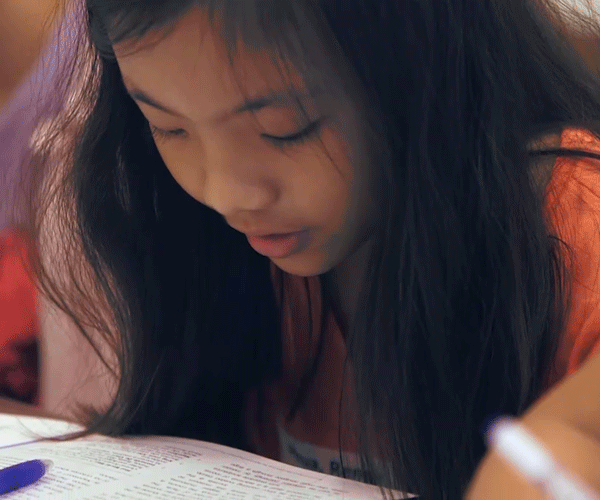
Do you have fond childhood memories of curling up in bed and losing yourself in prodigious fables about flying carpets and enchanted forests? The way the entire world around you faded away, while intricately whimsical worlds manifested right in your mind's eye, and the only thing that tethered you to reality is that exquisite woody aroma of the book you were fervently clutching on to?
How about your first visit to Narnia or Neverland through the pages of some of the most imaginative fantasies brought to life? Have you ever held your breath both in excitement and trepidation when The Famous Five stumbled into an eerie cave filled to the brim with treasures galore?

Perhaps you have, on more than one occasion, camped out in your local library for hours, enraptured in the Harry Potter series, reading at the speed of light and anxiously flipping through the pages to find out if Voldemort and his barbarous Death Eaters got their just desserts in the end.
Whatever images your mind evokes of your literary journeys as a child, they are doubtlessly rich and resplendent. Books are portals to infinite dimensions. Opening one as a child means that you have a high possibility of being whisked away to a magical dimension, transcending space and time, where you are ensorcelled into living within its pages forever and ever... or at least until the story ends.
Now that you're a parent watching your own child grow up, you too, would like to bestow the joys of reading upon them. However, in this modern age of technological distraction, can you really get your child hooked on reading?
Would they perceive it as “lame” and boring, especially when they interact with numerous astonishing feats of technology on a daily basis, some which allows them to see a friend face-to-face with a tap on their handphone screen and even take a glimpse into the lives of celebrities?
You can guide your child away from all these technological distractions simply by showing them the pleasures of reading. More often than not, when children display a reluctancy to reading, it is due to them drawing an unpleasant relation to school. School is where your child has to read, but through the 5 techniques below, you can transform your home into a place where your child wants to read.

1. Tickle your child’s imagination with illustrated story books
Children have a colourful imagination and illustrated story books can resonate with their bright, playful and inquisitive minds. A good illustrated story book is not just a lot of fun, they are a work of art to behold too.
The pictures are there to work in tandem with the text in delivering the story, and give your child contextual clues to words that they may not be familiar with.
For instance, if your child picks up an illustrated version of Coraline by Neil Gaiman (typically recommended for ages 13 and up), and while perusing through its pages, encounters the word “nefarious” (meaning: extremely wicked or villainous); despite being unfamiliar with its definition, the context in which “nefarious” is pictorially represented can already suggest its meaning.
This allows your child to instinctively pick up new vocabulary to build up their repertoire of words without going through the tedious act of scouring through a dictionary for its definition.
Picture books also strengthen visual thinking skills, allowing your child to connect how they reason with what they read and observe. As your child reads through an illustrated book, they are able to associate various concepts (no matter how grand and intricate) to words. Children tend to understand more complex concepts better when accompanied by a relatable story and aesthetically pleasing visuals.

2. Draw connections between written stories and real life
Steve Jobs once said that “creativity is just connecting things”, and the inner workings of the brain confirm this. This difference between a highly creative brain and an average brain boils down to the ability to make connections.
Creativity is the process of self-expression. By cultivating your child’s creativity when it comes to reading, it gives your child the freedom to commit themselves to the effort, which makes reading a more enjoyable process.
Furthermore, children who are able to monitor their own thought processes and make connections between fictional stories and their own real-life experiences are able to understand the text they are reading on a deeper level.
To train your child in gaining a more profound understanding of the text by making authentic connections, you can ask them some of the following questions:
- What does this story remind you of?
- Can you relate to any characters in the story?
- Does anything in this story remind you of anything in your own life?
From here, your child will increasingly be able to relate to the stories, which will promote a more immersive reading experience. Additionally, your child can develop better comprehension skills.

3. Read your favourite stories to your child
Do you remember which storybooks left an interminable impression on you when you were a child? Sieve through those memories and pass on those fantastical moments to your child.
Young children are paying attention to the world around them at every waking moment, and they learn by imitating adults. This offers you the opportunity to impart your love of reading to them.
When your child sees you devoted to reading or actively trying to engage them in reading, they may be more inclined to pick up the hobby as well.
Moreover, reading your favourite childhood stories to your child can form a stronger bond between parent and child and allows them to get to know you on a deeper level by offering a glimpse into your mind when you were an adolescent. It also offers a respite for you and your child’s stressful day-to-day activities.
Every book you read to your child will leave behind some trace and memory. Those memories made can go on to build on themselves within your child’s mind and lead to other good things.
“A minute spent reading to your kids now will repay itself a million-fold later, not only because they love you for reading to them, but also because, years later, when they’re miles away, those quiet evenings, when you were tucked in with them, everything quiet but the sound of the page-turns, will, seem to you, I promise, sacred.” — George Saunders

4. Introduce difference genres
When it comes to reading, even the most prolific reader has a preference as to the genres of books they like or dislike.
If your child dislikes reading, it can probably stem from their aversion towards certain genres which they have read. Helping your child discover reading genres that interest them makes the quest towards developing them into enthusiastic readers much easier.
The following tips can help you introduce your child, no matter their age, to different book genres:
- Discuss the genres they already know.
Ask your child to think about their favourite books and stories and the genres they into. They may be surprised to find out that they like more genres than they think. - Learn how books are categorised.
Visit your neighbourhood library to point out how the different types of books are categorised and let your child wander around to explore. - Read a new genre every month.
Try to check out at least one book of a new genre every month. Read and discuss similarities and differences compared to other genres which your child is familiar with. - Play genre bingo.
Create a bingo board and fill the squares with different genres. With each book your child reads, let them cover or fill the corresponding genre square with a sticker. When they get bingo, treat them to something.
Exposure to different genres opens your child's eyes to the enormous range of books that are available and new realms of possibilities to the different ways of writing.
Whether it’s stories about whimsical worlds, romance, poetry, historical events or autobiographies, your child will bound have a predilection towards a specific one or several.

5. Create a cosy reading environment
Having a peaceful reading space can make a huge difference in supporting your child’s reading interest. Imagine a living room with a lot of foot traffic or and road activity — this would be highly distracting; or a dark room that invites sleep, which would be demotivating.
Set a conducive environment for reading by creating a bright, airy, lightly colourful space with comfortable seating or even a mattress or hammock for laying.
Ensure that the space is well insulated from noise and other sensory diversion. A cosy reading environment must be inviting and relaxing; a sweet shelter for solitude where chores and concerns could melt away.
Reading Between the Lines
While children who read are more likely to excel academically, there is much more to the picture. It has been observed that children who show a proclivity towards reading in their own free time are also better at self-regulation and executive function — a set of mental skills that regulates working memory, flexible thinking and self-control for daily life.
In turn, other than simply adding on to their vocabulary bank and showing them what good writing comprises, if you can successfully get your child to show a genuine interest towards reading, it allows them to develop enduring life skills which can make them happier by facilitating the ability to control impulses, pay attention, set goals and figuring out how to achieve them.

Through indulging in the stories encapsulated within books, your child will be better equipped in handling whatever life holds for them.
They will understand story lines, plot twists and tragic endings, character developments and underlying themes.
With the gradual acquisition of numerous insights from storybooks, your child can understand the narrative of the stories they want to be a part of in real life, and what kind of character they are or want to be.
Your child will be better prepared to read situations and infer from complex concepts and contexts.
Essentially, they will know how to break a story down to its basic elements and draw conclusions on their own.
Your Child’s Story
At TLL, we foster the love of reading in our students through the strategic placement of a library in every single one of our centres.

Our libraries house more than 77,000 specially curated books, shelved according to our recommendations for different levels that encourages our students of all ages to extend their learning beyond the classroom.
Our conducive libraries are designed to provide students with comfortable reading spaces.
Our students can be found with their noses in the books before classes start, and at the end of lessons when they wait for their parents to pick them up.
Our teachers themselves also play a big part in our students’ reading life, through story telling sessions (with books cherry picked from our in-house library) that engages our students, hone their comprehension skills and encourages them to think out of the box.
Students can even borrow multiple books from our library, with the option of asking their teachers for recommendations that correspond to their reading abilities.
According to a happy TLL parent: “Also, am I the only one getting excited with The Learning Lab library? Lauren’s teacher lovingly picks six books each week for Lauren to read at home — three books to read on her own and another three which are slightly more difficult for parent-child storytelling. Based on her observation on the very first day, Lauren is at Level 8 which honestly, I thought was too hard for Lauren. But Lauren could read those books all by herself. Imagine my surprise!”
Instead of simply focusing on “exam readiness”, our dedicated educators would like to impart “life readiness” as well. By setting out with the intention of moulding every child into an enthusiastic reader, our English teachers endeavour in guiding our students to excel way beyond their academic life.
It is our fervent desire that through reading, our students are able to seize on books as their own lifelines and share their stories with others. Click here to discover the enriching topics that we have in store for our nursery to junior college students.
The Learning Lab is now at locations. Find a location that suits your needs.
If you have any questions about our range of programmes or class schedules, you may contact us at 6733 8711 or drop us an email at enquiry@thelearninglab.com.sg.


